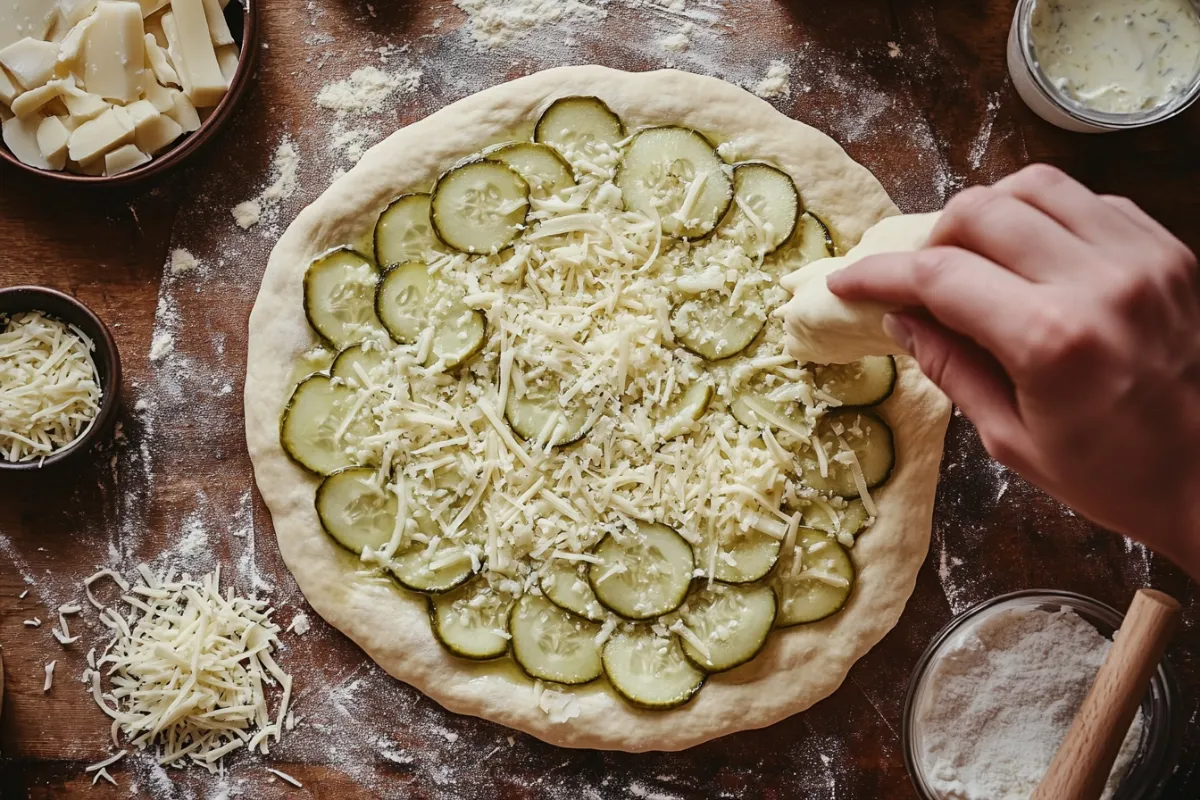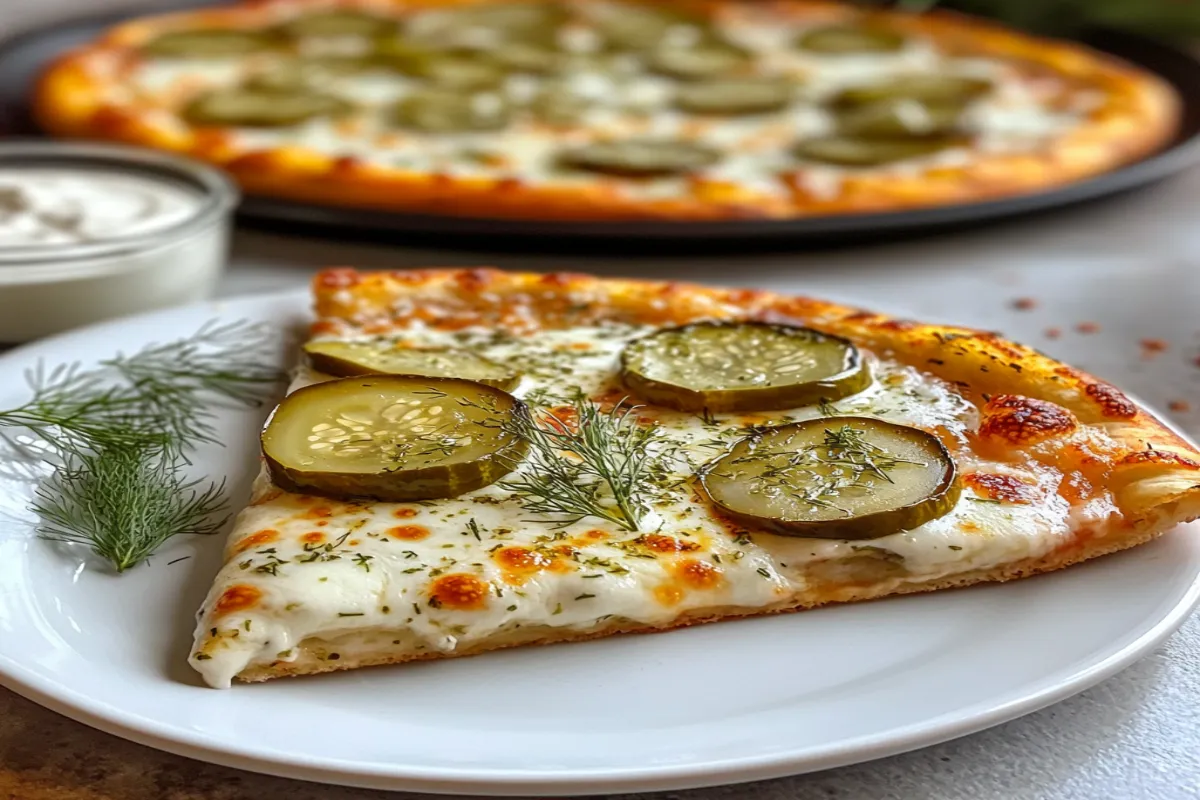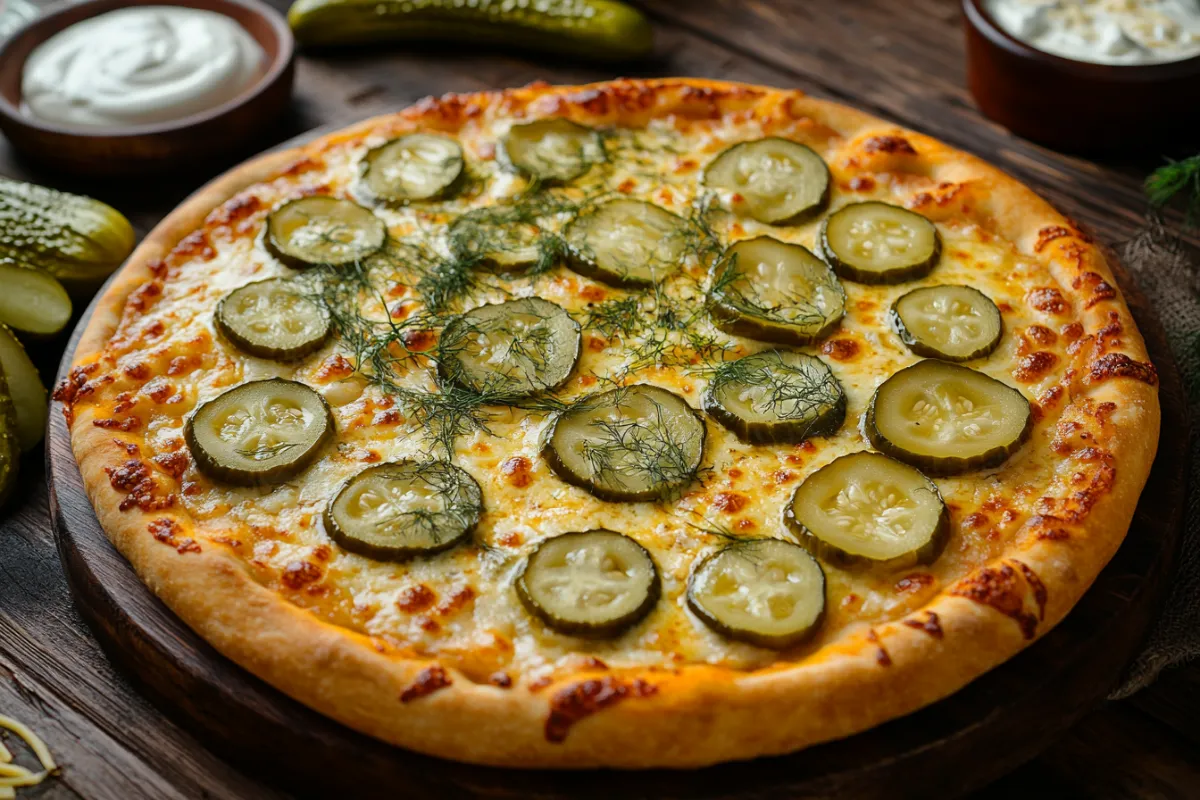Part 1: Introduction and History
Introduction to Pickle Pie Pizza
Pickles on pizza might seem like a wild combination; however, it’s precisely this unusual twist that has captivated many food lovers. Imagine a savory crust topped with gooey cheese, crisp dill pickles, and garnished with toppings that make your taste buds dance. Pickle pie pizza is more than just a quirky recipe—it’s an adventurous exploration of flavor that pushes the boundaries of traditional pizza making.
The rise of pickle pie pizza has been fueled by both food bloggers and culinary experts, pushing boundaries in kitchens everywhere. Its popularity is partly due to how it provides a surprising yet harmonious flavor combination that blends the tanginess of pickles with the creamy richness of cheese. As a result, this unconventional pairing has taken social media by storm, with numerous food enthusiasts sharing their unique takes on the classic dish.
The Origin and Evolution of Pickle Pizzas
The concept of adding pickles to pizza didn’t emerge from a single moment of inspiration but rather as part of the growing desire for new and innovative toppings. Over time, this pizza found its way to the spotlight through creative chefs and pizza enthusiasts, gaining popularity in unique and unexpected ways.
One of the pivotal moments in this journey was the feature of chef Ann Kim’s pickle pizza in the Netflix series “Chef’s Table.” The exposure showcased this culinary experiment to the masses, inviting food enthusiasts to try their hand at this unusual yet delightful concoction. If you want to read more about Ann Kim and her inspiring culinary creations, you can check this feature on Ann Kim.
Pickle pie pizza initially began as a local trend in small pizza shops, but soon found its way to social media, where it gained significant popularity. The use of pickles wasn’t just a novelty; instead, it was a representation of bold culinary choices, celebrating diverse tastes and new ingredients.
The Concept Behind Pickle Pie Pizza
Why add pickles to a pizza? The taste profile of pickles—salty, tangy, and slightly sweet—provides a compelling contrast to the creamy, fatty cheese and chewy crust of a traditional pizza. Moreover, the acidity of pickles acts as a palate cleanser between bites, allowing the other ingredients to shine even more.
The core idea is to balance the right amount of acidity, saltiness, and crunch, which enhances the pizza experience. Whether you love or dislike pickles. There’s no denying that pickle pie pizza is a fantastic representation of how far we can stretch the traditional boundaries of a beloved dish.
The Types of Pickles Used in Pickle Pie Pizza
One of the best things about pickle pie pizza is the variety of pickles that can be used. You can adjust the type of pickle to achieve different flavor outcomes, such as:
- Dill Pickles: The classic, providing a sharp, tangy burst of flavor that cuts through the richness of the cheese.
- Bread and Butter Pickles: These are slightly sweeter, adding a complex layer of flavor to the pizza.
- Garlic Pickles: For those who enjoy a strong garlic kick, these can provide a more robust, aromatic experience.
- Hot and Spicy Pickles: If you like your food with a bit of a bite, adding spicy pickles will create an excellent spicy pickle pizza.
Homemade vs. Store-Bought Pickles
Another consideration is whether to use homemade or store-bought pickles. Homemade pickles often have a fresher and more intense flavor, especially when you can control the spices and acidity levels. However, store-bought pickles are incredibly convenient and come in an array of different flavors to suit any pickle pie pizza variation.
For those interested in learning about how to make a homemade brine, check out this comprehensive chicken brine recipe to get an idea of different pickling techniques that could enhance your pizza toppings.
Part 2: Pickle Pie Pizza Recipe and Ingredients
Ingredients Needed for Pickle Pie Pizza
To make your very own pickle pie pizza, you’ll need some simple yet specific ingredients:
- Dough: You can use a store-bought crust or make your own for an authentic experience. A thin crust tends to work best to allow the flavors to shine. If you’re interested in gluten-free options, consider checking out this gluten-free pasta recipe. which can be adapted for a pizza base.
- Cheese: The classic choice is buffalo mozzarella, known for its creaminess, but you can also use taleggio or even cheddar for a more robust flavor.
- Pickles: Choose your favorite type, such as dill or bread and butter. Make sure to slice them evenly for a consistent flavor.
- Sauce: You can use a creamy garlic sauce instead of the traditional tomato sauce for better pairing with the pickles.
- Optional Ingredients: Additions like ranch dressing, dill weed, or salted chips can provide more complex textures and flavors to your pizza.
How to Make Pickle Pie Pizza at Home

Here’s a step-by-step guide to making the ultimate pickle pie pizza:
- Prepare the Dough:
- First, roll out the dough to your desired thickness, ideally keeping it thinner to let the flavors of the toppings stand out.
- Pre-bake the dough for about 5 minutes in an oven preheated to 450°F. This helps create a crispy crust that will hold the moisture of the pickles without becoming soggy.
- Prepare the Toppings:
- Next, slice your pickles into thin, uniform pieces.
- Prepare the cheese by shredding it or cutting it into small pieces for even melting.
- If using a garlic sauce base, apply it evenly on the partially baked crust.
- Assemble the Pizza:
- Spread an even layer of cheese over the crust, leaving a border around the edges.
- Then, distribute the pickle slices over the cheese, ensuring every bite will have a piece of pickle.
- Add any additional toppings, such as a sprinkle of dill weed or a drizzle of ranch dressing.
- Bake:
- Bake the assembled pizza for an additional 8-10 minutes, or until the cheese is bubbly and golden, and the crust is fully cooked.
- Finishing Touches:
- Once out of the oven, you can garnish with salted chips, dill, or a bit of chili powder for an extra kick.
- Finally, allow it to cool slightly before cutting it into slices.
Tips and Tricks for the Perfect Pickle Pie Pizza
Creating the perfect pickle pie pizza takes a little finesse. Therefore, here are some tips to ensure the ideal balance of flavors:
- Balancing Flavors: One of the keys to a great pickle pizza is balancing the acidity of the pickles with the richness of the cheese. If you find the taste too sharp, add a slight drizzle of honey to balance it out.
- Choosing the Right Cheese: Pickles pair best with creamy cheeses that can complement their acidity. Mozzarella, provolone, or cream cheese blends work well.
- Avoiding a Soggy Crust: Pickles contain a lot of moisture, which can make the pizza soggy. Pre-baking the crust and patting the pickles dry with a paper towel helps avoid this issue.
Common Mistakes to Avoid
- Overcooking Pickles: When pickles are cooked for too long, they can lose their crunchiness. Thus, add them towards the end of the cooking process or bake for a shorter duration.
- Cheese-Pickle Balance: Ensure that neither the cheese nor the pickles overpower the other. Instead, aim for a harmonious blend of both for the best pickle pie pizza experience.
- Too Much Moisture: Pickles have high water content. Therefore, consider patting them dry or even lightly roasting them beforehand to remove excess moisture.
Part 3: Variations of Pickle Pie Pizza
Regional Variations
Pickle pie pizza has regional variations that showcase different preferences and adaptations. Here are some notable versions:
- Midwest Dill Pickle Pizza: This version features thick-cut dill pickles, ranch dressing, and cheddar cheese, representing the Midwest’s love for comforting, rich flavors.
- Southern Bread and Butter Pickle Version: A sweeter take on the traditional dill pickle pie. Using bread and butter pickles and sometimes paired with smoked bacon.
- International Twists: From adding Italian herbs to using spicy Korean pickles (kimchi-style), international twists have brought unique flavors to this pizza trend.
Creative Variations of Pickle Pie Pizza

The versatility of pickle pie pizza allows for creative variations, including:
- Bacon and Pickle Pizza: Adding crisp bacon pieces not only enhances the flavor but also provides a contrasting texture to the soft pickles and cheese.
- Spicy Pickle with Jalapeños: For spice lovers, adding jalapeños along with spicy dill pickles brings a fiery twist. Thus, this version is ideal for those who like their pizza to have a kick.
- Vegan Options: Substitute dairy cheese with vegan cheese and ensure your dough is dairy-free. Vegan pickle pie pizza can be just as flavorful when using nut-based cheese and fresh herbs.
Part 4: Serving and Pairing Suggestions
The Best Side Dishes to Serve with Pickle Pie Pizza
The unique flavor profile of pickle pie pizza can be complemented with a variety of side dishes:
- Dips:
- Ranch Dressing: A classic that complements the tanginess of pickles.
- Garlic Butter: This adds a layer of savory richness.
- Spicy Aioli: For those who want a little extra kick, spicy aioli can be a great addition.
- Side Salads:
- A light, fresh garden salad with vinaigrette helps balance the richness of the pizza.
- Additionally, a cucumber and dill salad provides complementary flavors that enhance the overall dining experience.
Beverage Pairings for Pickle Pie Pizza
Pairing the right beverage with your pickle pie pizza can elevate your culinary experience:
- Craft Beers: The acidity of pickles pairs wonderfully with light, crisp craft beers. Therefore, try a Pilsner or a Pale Ale to balance the saltiness and cut through the richness of the cheese.
- White Wines: A crisp, dry white wine, like a Sauvignon Blanc, offers a refreshing balance to the acidity of the pickles and the creamy cheese.
Part 5: FAQs and Final Thoughts
- Q1: Can I Use Sweet Pickles on Pizza?
- Yes, sweet pickles like bread and butter pickles offer a different flavor profile. Making the pizza slightly sweeter and adding complexity.
- Q2: What’s the Best Cheese to Pair with Pickles on a Pizza?
- Creamy cheeses like mozzarella, provolone, and taleggio work best with pickles. They provide a rich base that balances the acidity of the pickles.
- Q3: Can I Make Pickle Pie Pizza on the Grill?
- Absolutely! Grilling gives the crust a smoky flavor, which adds depth to the tangy pickle and creamy cheese combination. Just ensure to use a pizza stone and monitor the temperature closely.
- Q4: Is Pickle Pie Pizza Suitable for Kids?
- It depends on your child’s taste preferences. If they enjoy pickles, they may love the salty and tangy flavor combination of pickle pie pizza.
Conclusion
If you’re someone who loves trying unique flavors and experimenting with new culinary experiences, pickle pie pizza should be next on your list. It’s not just a novelty item; rather, it’s a delightful combination of tastes and textures that will surprise you in the best way possible. Whether you prefer your pickles spicy, sweet, or classic dill, there is a version of pickle pie pizza for everyone.
So, the next time you’re hosting a pizza night or just looking for something out of the ordinary, try making a pickle pie pizza. Your friends and family will be impressed with the bold flavor choices. And you might just convert a few skeptics into pickle pizza lovers!

